Pencil Cactus (Firestick Plant): Succulent Care and Growing Guide
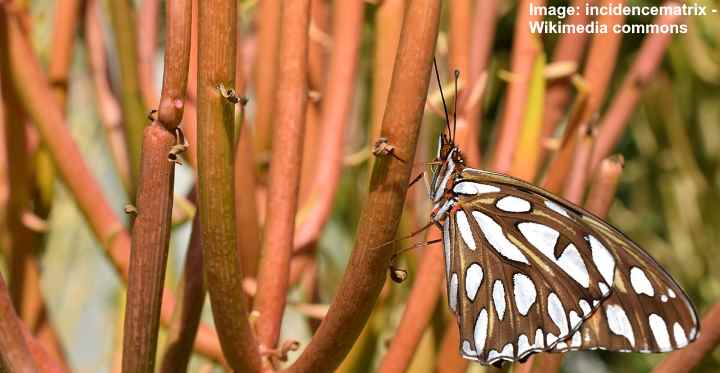
The firestick plant (pencil cactus or Euphorbia tirucalli) is a type of succulent, not a cactus. The firestick succulent is also named pencil cactus, stick cactus, fire plant, pencil plant, and ‘sticks on fire.’ Pictures of the firestick plant show how it gets its name. The succulent has clumps of pencil-like stems exhibiting an orangey-red color that looks like it’s on fire.
The firestick plant is a shrubby succulent in the family Euphorbiaceae. ‘Fire sticks’ is a cultivar also named ‘Rosea’ of the usually very tall pencil cactus (Euphorbia tirucalli). It is a very ornamental plant to decorate any garden or landscaped space with its stunning stem color.
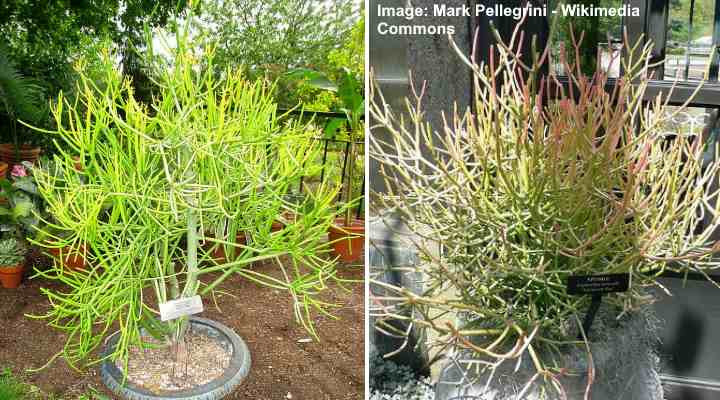
The firestick plant (pencil cactus or Euphorbia tirucalli) has green stems (left). ‘Rosea’ cultivar (also called ‘fire stick’ or ‘sticks on fire’ has reddish orange stems, especially during winter when the color is most intense (right)
The firestick plant has fleshy stems that grow in clumps and look like short red, orange, yellow, or green twigs. Because of its impressive growth and predominately red colors, firestick plant bushes resemble sea coral. The shrubby succulent has small branches about 0.27” (7 mm) thick.
Despite its common names (pencil cactus or firestick cactus), the pencil plant (firestick plant) isn’t a type of cactus. Unlike cacti, firestick plant grows small oval leaves. Firestick plants are not in the same botanical family of cacti. While firestick belongs to a family of succulents, cacti are in the botanical family Cactaceae.
Because the firestick plant has a toxic milky sap, you should always handle it with care.
How to care for a firestick plant: The firestick cactus is an easy succulent to grow. The firestick plant thrives in bright sunlight, warm temperatures, and low humidity. Ensure the plant grows in well-draining soil. Only water the plant occasionally when the soil dries out.
The article is a comprehensive care guide for growing firestick plant succulents. Before looking at how to water, propagate, and grow the cactus-like plant, it’s essential to know about its toxicity.
The Firestick Plant Is Poisonous

Pencil cactus contains toxic substance for humans and pets so you should handle it with extreme care
The firestick succulent contains an acidic white substance that’s toxic to dogs and cats. The irritant sap in the pencil plant causes vomiting and mouth irritation if animals ingest it. If you have pets at home, you should protect them from exposure to these ‘fire sticks.’ (1)
Similar to other types of Euphorbia plants, it’s vital to make sure that pets don’t bite or chew on this succulent.
The Firestick Cactus Causes Extreme Skin and Eye Irritation
Firestick plants can cause severe irritation to humans. Studies show that Euphorbia tirucalli toxic latex sap can severely irritate the skin and eyes.
Some reports indicate that, in some cases, contact with the firestick’s toxic sap can cause serious complications. It is usually unintentional exposure to the poisonous milky latex that causes the most problems. Complications can include skin or eye irritation, mouth burning, and gastrointestinal problems.
Pencil Cactus (Firestick Cactus) Safety Precautions
Always wear protective gloves, clothing, and goggles when handling firestick succulents. It’s crucial to keep the plants away from children, who could inadvertently chew on the fleshy stems. Also, wear gloves and protect your eyes from sap splashes when propagating a firestick.
The irritating sap oozes out of the plant if the succulent stems are broken. If the white latex gets on your skin, you could end up with severe dermatitis. Some people could go into anaphylactic shock due to a severe allergic reaction. In the worst cases, the toxic white sap can cause blindness if it gets into the eyes.
Due to its poisonous sap, many people decide not to grow the plant indoors.
Despite precautions about the toxicity of the firestick plant, the sizeable shrubby succulent can create a stunning colorful landscape feature in a backyard.
Firestick Plant Hardiness
Firestick plants are cold hardy to 25°F (-4°C) and grow in USDA zones 10 – 12. The hardy succulents can tolerate temperatures as high as 100°F (37°C). Its ideal temperature range is 50°F to 70°F (10°C – 21°C).
Firestick Plant (Pencil Cactus – Euphorbia Tirucalli) Care
Let’s look in more detail at how to grow a healthy, thriving firestick plant. The three essential care tips for growing firesticks are bright light, sandy soil, and occasional watering.
Pencil Plant Light Requirements
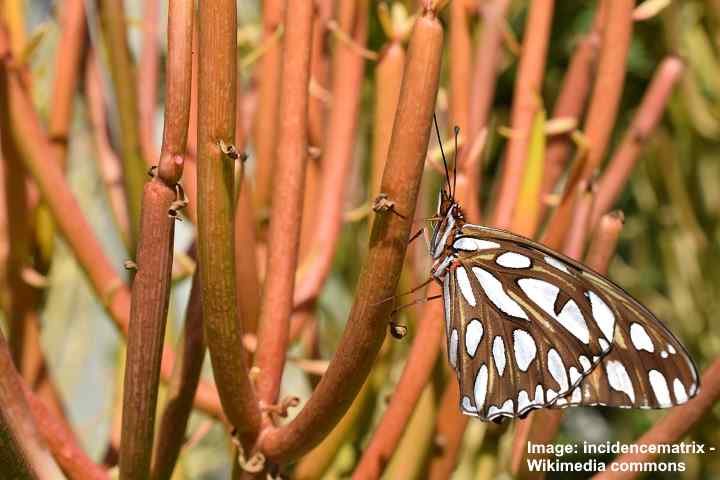
Grow your firestick plant in plenty of sunlight
Firestick plants require between four and six hours of bright light daily. Grow firestick succulents in the sunniest spot in your backyard. Plenty of sunlight and heat during summer turns the beautiful foliage yellow before it turns glowing red in the fall and winter.
Growing indoors, firestick potted plants need as much light as they can get. Place the succulents near a south- or west-facing window for best results. To ensure even growth, turn the plant pot every month so that the firestick plant gets enough light.
It’s good to remember that these ‘sticks of fire’ are not plants that thrive in low light conditions.
Firestick Plant Soil
Firestick plants need to grow in sandy soil with excellent drainage. The ideal growing medium for firestick succulents is a cactus soil mix that doesn’t retain moisture. If necessary, you can work in perlite to the planting area to improve drainage for your succulent ‘fiery sticks’ to thrive.
Because firestick plants are ideal for rocky, infertile soil, they are suitable for rock gardens along with other types of succulents. Or, you can plant ‘sticks on fire’ in container gardens in your yard.
To create the ideal potting mix for growing firestick plants in containers, use a combination of cactus mix and perlite. Combine two parts of cactus potting soil with one part perlite. The plant soil for growing pencil cacti should be porous enough to allow water to drain quickly.
In general, you don’t have to worry too much about the growing medium for firestick plants. As long as drainage is excellent and it doesn’t retain too much moisture, you should have no trouble caring for your succulent firesticks.
How to Water a Firestick Plant
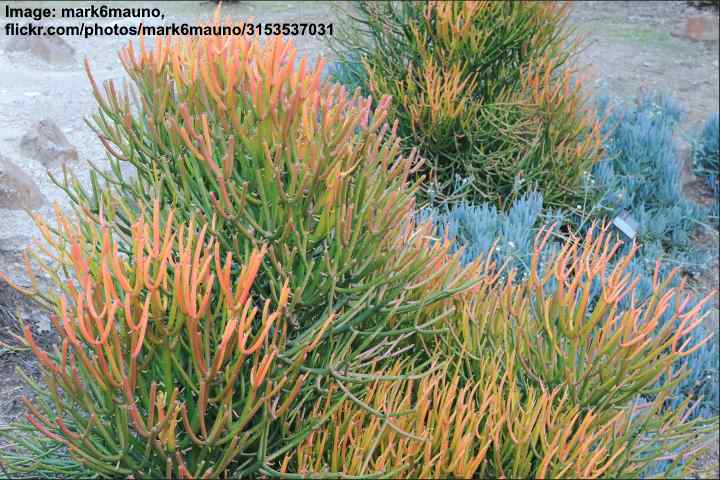
Being a succulent, water your fire plant only when the soil has dried out
Only water a firestick plant when the soil dries out. The frequency of watering your pencil plant depends on the temperature and season. During a hot, dry summer, you may have to water a firestick plant as often as every one to two weeks. In winter, you’ll hardly need to water your plant at all.
Firestick plants need to dry out between watering. One of the worst things you can do is to over-water the plant. This can happen if you water the succulent when the soil is still moist. Remember that the firestick cactus is a type of drought-tolerant plant. Occasionally not giving it enough water is better than watering it too often.
When you water a firestick plant, always thoroughly drench the ground. This type of watering technique ensures that roots get adequately hydrated. But you have to remember to wait until the soil has dried out before irrigating the plant again. The ‘soak and dry’ method for watering firestick plants is necessary for watering succulent plants outdoors or indoors.
If you have firestick shrubs growing in your garden, occasional rainfall during the spring and summer months may mean you don’t have to water the succulents at all. But if you notice the short pencil-like stems becoming wrinkly and brown, it could be a sign that you need to water your firestick plant.
Pencil Plant Temperature and Humidity
Firestick plants thrive in temperatures between 50°F to 70°F (10°C – 21°C). Although the firestick succulents can withstand some frost, they need to grow in temperatures at least 30°F (-1°C). Even in hot, arid climates, firestick succulents can still flourish when it’s 100°F (37°C).
If you live in areas that have regular frost in the winter, you can protect the plants from extreme cold. Cover with frost cloths or use a mini greenhouse to help the succulents survive. It’s worth keeping firestick cacti outdoors in the fall and winter to enjoy the stunning red foliage when the pencil twigs turn color.
As with most succulents and cacti, firestick plants prefer a dry, arid climate. So, growing indoors or outdoors, you don’t need to humidify the air. Just ensure there is good air circulation to keep the plant thriving.
Firestick Plant Growth Rate
Young firestick plants have a rapid growth rate that gradually slows as the plant matures. Under cultivation in gardens or containers, a firestick shrubby tree can grow up to 6 ft. (1.8 m).
Fertilizing a Firestick Plant
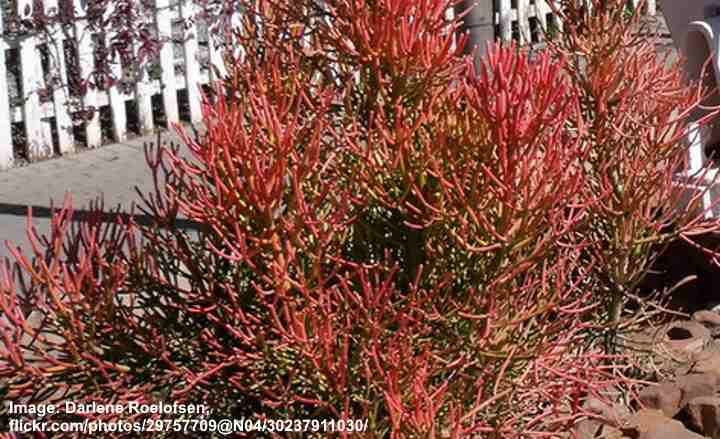
Firestick succulent is a hardy plant with very modest fertilizing needs, if any
Firestick plants have modest fertilizing needs. These hardy pencil succulents thrive in poor soil and can adapt to most growing conditions. If you want to give your plant a nutritional boost, fertilize once a year in spring with a weak, diluted houseplant fertilizer.
It’s vital to remember that over-fertilizing can be just as detrimental to its growth as too much watering. You should find that by following the three essential firestick plant care tips—bright light, sandy soil, and occasional water—your succulent will thrive without feeding.
How to Prune Pencil Plant
Firestick succulents rarely need pruning. The only time you need to trim the firestick plant’s foliage is when dead leaves appear on the plant or to control its size. Or, you could snip off stems to get cuttings for propagation. But remember—whenever you handle a pencil plant, you much wear protective gloves and eye protection.
When you cut the leaves, you will notice a milky sap oozing out. This irritating latex substance is a reason why the firestick plant goes by the name of ‘milk bush.’ Make sure that none of the plant’s sap touches your skin.
Here are some tips on how to prune a pencil plant safely:
- Put on thick rubber gloves, protective goggles, and make sure you have no exposed skin.
- Using sterile pruning shears, remove dead stems.
- Prune branches from the top of the plant to help reduce its height and encourage bushy growth.
- After cutting stems, spray the ends with water to stop the toxic sap from oozing out.
- Unless you’re taking cuttings for propagation, dispose of all cuttings in the trash in a sealed plastic bag.
- Thoroughly clean and disinfect all equipment to remove the toxic white sap.
Firestick Propagation
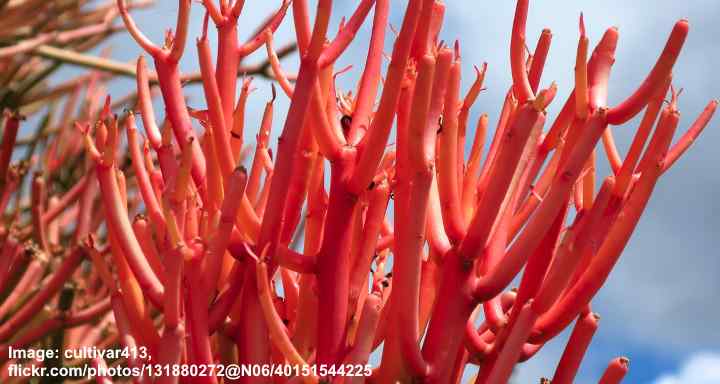
You can easily propagate pencil plant using stem cutting
It’s easy to propagate a firestick plant using stem cuttings. To propagate a pencil cactus, put on gloves and goggles and snip off a healthy stem. Dip the stem’s end in water to stop the sap from oozing. Let the firestick cutting dry for a few days to callous over and plant in succulent soil.
Cuttings from pencil plants root very quickly, and soon you’ll have a new succulent growing.
Here is a propagation tip: it’s best to allow the cut end to callus over to ensure successful pencil plant propagation. Letting the cutting dry for several days prevents soil moisture causing root rot in your new plant.
Care of pencil plant cuttings
There are a few precautions to take to ensure that your new firestick cuttings root well. First of all, it’s crucial to protect your skin and eyes from the toxic sap. Second, the cuttings need to dry before replanting to ensure healthy propagation.
To help grow a new pencil plant grow, plant the cuttings in small pots with a soilless medium. Keep the cuttings in low light to help them root and mist them to keep them moist. In a couple of weeks, gradually increase the brightness and reduce misting. Once the new cuttings are established, you can care for the firestick plant as usual.
Pests Affecting Firestick Plant Growth
Houseplant pests that can affect firestick plants are mealybugs, spider mites, and aphids. Thankfully, most pests stay away from these toxic pencil succulents. However, it’s good to be aware of the common signs of a plant bug infestation. Use insecticidal soap or neem oil to remove pests from firestick plants.
Usually, a healthy firestick plant is resistant to pests. But if over-watering has caused root rot, you may see mealybugs leaving traces of fuzzy white stuff on the pencil-like twigs. If you notice webbing on the bushy succulent, it could be a sign of spider mites.
Related reading: How to get rid of houseplant bugs naturally.
Diseases Affecting Pencil Plant Growth

Euphorbia tirucalli is susceptible to root rot if watered too frequently
Root rot is a common disease that affects firestick plants. The best way to avoid succulent diseases is to water your pencil plant appropriately. Never water the plant if there are any signs of moisture in the soil. Always allow the soil to dry to prevent roots from sitting soggy soil and decaying.
Things to Consider Before You Plant Firestick Plant
Firestick succulents are toxic plants that can result in severe skin, mouth, and eye irritation. Most people avoid keeping ‘sticks of fire’ as houseplants due to their toxicity. In the backyard, avoid planting the succulent shrubs as border plants or where kids or pets could easily run into them.
There is another consideration of growing firestick plants in pots. The bushy succulents are fast growers—faster than other succulents. Their rapid growth rate means that you’ll have to repot them frequently, increasing the risk of exposure to the milky toxic latex.
Common Problems Growing Firestick Plant (Euphorbia tirucalli) Outdoors or indoors
How to know if a firestick succulent is getting too much water
Over-watering a firestick plant causes the succulent stems to become droopy. The fleshy stalks may lose their green, red, or yellow colors and turn an unsightly gray or brown color. To help revive an over-watered pencil plant, don’t water it until the soil dries out.
In severe cases, you may need to repot the succulent in fresh, sterile potting soil.
Why is my firestick plant turning brown?
Brown pencil stems on a firestick plant are often the result of sunburn. Although the firestick plant needs up to six hours of sunlight daily, extreme sun can burn the leaves and stems, turning them brown. Give the pencil plant some shade if it’s getting too much direct sunlight.
Is it safe to grow a pencil plant indoors?
Generally, it’s not advisable to keep a firestick plant indoors. The toxic succulent requires special care when pruning it. Also, kids or pets could get the irritating white sap on their skin or eyes, which will result in significant discomfort.
Why is my firestick plant dying?
Usually, a pencil plant—just like cacti and succulents—will begin to die if you over-water it. Mushy stems, discolored foliage, and drooping growth are all signs of too much moisture in the roots. Follow the care tips for watering a firestick plant to prevent it from dying.
Related articles:
